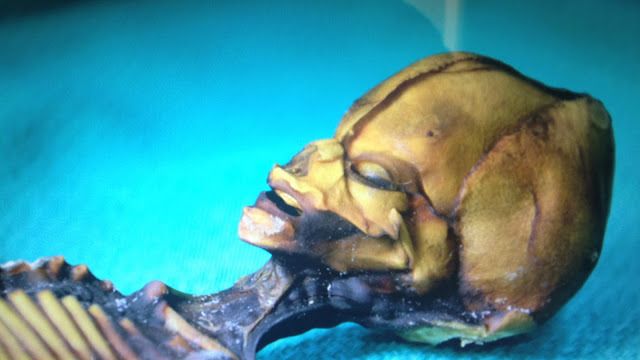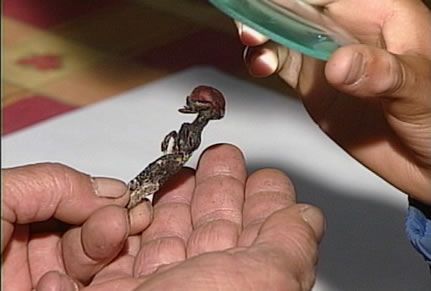 |
| Image found here. |
Last
month I blogged about the Atacama humanoid. I find this
hoax fascinating and judging by the number of page hits you guys do
too. Well, you're in luck: there's more! A guy called Dr
Stephen Greer has just released a documentary (I use that
term loosely in this context) titled Sirius, in
which he claims to analyse the specimen. So this
weekend I put on my tinfoil hat, made some popcorn, and settled down
to watch Sirius so that you don't have to.
Here is my review:
I
honestly can't recommend this film. I certainly don't recommend
that you pay money to watch it. Although the hype for the film revolves around the "extraterrestrial" specimen, the film barely mentions it at all. This, I suspect, is because there
really isn't a lot to say about the specimen. It's a clever
little hoax, but it won't be revealing the secrets of life on other
worlds anytime soon.
 |
| X-ray image of the specimen. You can see that, whatever it is, it certainly has skeletal tissue. |
Sirius is
mostly just two hours of rambling self-aggrandizement from Dr
Greer. It's pretty standard stuff - "they" have
managed to back-engineer free energy technology from alien
spacecraft, but "they" don't want you to know
about it. "They" are poorly defined and
could involve the military industrial complex, the Milk
Marketing Board*, the New World Order or the Reptilians according to
your preference and/or level of disconnection from reality.
Sirius does its best to imply that the specimen could be a human/alien hybrid, but we're not given any information about how that could be possible, or even how the specimen relates to anything else Greer talks about in the film.
When Sirius finally
gets around to discussing the Atacama humanoid it does not provide
any new information. The specimen has been tested for DNA by
one Dr Garry Nolan, who is a reputable geneticist at Stanford
University. Why he agreed to appear in this film is a mystery
to me. Dr Nolan says that the specimen appears to contain DNA
that is similar to human DNA, but that at this stage the results are
inconclusive. This apparent similarity between DNA found
in the specimen and human DNA does not actually get me overly
excited. Lots of people have been handling that thing for years
without wearing gloves. How do we know their DNA hasn't
contaminated the specimen?
While
the analysis was inconclusive, it does suggest the very interesting possibility that
the specimen may be at least partially made from human tissue.
Dr Nolan is pretty clear that he doesn't think it's a monkey, though
he doesn't tell us why. Based on the epiphyseal plates, he
thinks it lived to be about 6 or 8 years old. But there is no
medical explanation for how a child could have survived like this for
several years or even what might cause a child to look like this in
the first place. I think Dr Nolan has made a mistake somewhere
along the way, or what he said has been taken out of context.
Either the thing is made from animal parts, or it's a fetus. It
may possibly be a mixture of both, with some human parts and some
parts from other animals. Dr Nolan says he plans to write a
paper on the specimen, and I can't wait to read it.
With all due respect to Dr Nolan, I'll need to see some peer review before I take his 6 year old hypothesis seriously. A composite specimen made from small animal bones with some human DNA that got in there via contamination would explain the epiphysial plates in a much more believable way.
 |
| Maybe it's just me, but I'm having a tough time believing this could be the remains of a 6 year old child. |
Sirius completely avoids
the most important question: if this specimen really is something so
extraordinary, why hasn't it been all over the news before now?
Remember, this thing has been around for ten years. If it
really was a previously unknown medical condition or an unknown
species, we'd have heard about it before now. Instead, it looks
like Dr Greer has recently gotten hold of the thing and decided to
make money off it, P. T. Barnum style. A quick browse around
some of the truthseeker forums tells me that many of the folks who
post there don't rate Dr Greer highly and think he's a charlatan out
to make a quick buck. In other words, even people who tend to
be receptive to these sorts of concepts think Dr Greer is full of it.
Basically, Sirius is
a transparent attempt to separate fools from their money.
Dr Greer is using the Atacama specimen to get people interested in
his film, which is really just a rehash of a tired old conspiracy
theory trope and has nothing to do with the specimen itself. I
guess at least Greer isn't selling quack cancer remedies or
stealing credit card details, but still, my advice is don't waste your money.
*I
enjoy Tom Holt novels and believe me, this film really does remind me
of Danny Bennett.
Comments
Post a Comment